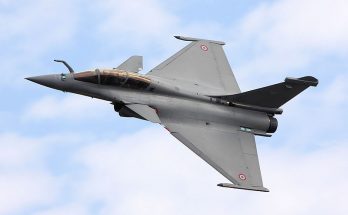The Belgian government has signaled its intent to modernize and recapitalize its long-neglected military capability with funding worth nearly €9.2 billion ($10.45 billion) directed towards defense investments. The fiscal commitment secured with parliamentary approval was announced by Defense Minister Steven Vandeput on October 26.
Roughly half of this allocation – anywhere between €4.011 and €4.658 billion ($4.56-$5.29 billion) – is earmarked for the F-35 acquisition program involving the procurement of 34 of the stealth multirole combat aircraft to replace the Belgian Air Force legacy fleet of F-16s. The first of these 34 F-35A Block 4 fighters is slated for delivery around 2023. Belgium announced its selection of the Lockheed Martin F-35 Lightning II over a British offer for the Eurofighter Typhoon on October 25.
In addition, Belgium plans to procure new combat vehicles under a privileged partnership with France. The €1.6 billion ($1.81 billion) purchase will involve 60 Jaguar medium and 382 Griffon light armored combat vehicles under the CAMO (MOtorized CApacity) program.
.#Nexter #GRIFFON and #JAGUAR for #Belgian #LandForces – Belgium and France Establish CaMo Land Mobility Partnershiphttps://t.co/I2rtMZXcGm pic.twitter.com/P0FcWDLsfI
— Monch Publishing (@MonchPublishing) October 29, 2018
Under the CAMO program the new vehicles will replace the Belgian Land Component’s legacy Piranha 3C and Dingo II armored vehicles currently operated by the Motorized Brigade. They will be structurally built by France’s Nexter with final assembly for the Griffons and 40mm turret integration for the Jaguars undertaken by Belgium’s CMI Defense. Delivery and entry into service for the vehicles will run from 2025 through 2030.
A third prong in the modernization effort involves the acquisition of two MQ-9B SkyGuardian medium-altitude long endurance (MALE) unmanned aerial systems (UASs). The Council of Ministers has given the Defense Ministry the green-light to launch negotiations with the U.S. for the procurement of these drone systems under an estimated cost ranging from €226 million ($256 million) to €360 million ($408 million). Deliveries are expected to run anywhere from 2021 through 2024, but with an in-service target of 2025.
Additional SkyGuardian drone systems (2-4) will then be purchased at a later date with the intention of bringing these follow-on units into service around 2030.
In the wake of the end of the Cold War, Belgium underwent a military downsizing similar to those undertaken across the NATO Alliance spectrum. Its once sizable armed force was cut in half, conscription was eliminated and defense spending slashed from less than a third of what it represented as a share of GDP in 1980 down below 1 percent.
Following a 15-year reorganization plan launched in 2000, the Belgian armed forces were wholly revamped with a shift in posture from static territorial defense toward flexibility, joint operations, mobility, and interoperability with NATO partners.
But as in the case with most European NATO members, the military capabilities were stripped from a more kinetic-operational basis to a lighter, more mobile peacekeeping and security mission-oriented footing. High intensity operations were largely considered a thing of the past.
While a return to a homeland defense, heavy-armored high-intensity warfare force structure is not forthcoming, the need to undergo a modernization of military capabilities is nonetheless a necessity. Also of importance is a rebalancing of annual defense budgets with an eye on shifting some of the financial emphasis into operations and capital investments rather the overwhelmingly being earmarked for soldiers’ pensions, salaries and overall welfare.
The latter goal forms part of the basis behind Belgium’s ‘Strategic Vision for Defense’ (or, alternately, the ‘Strategic Plan 2030‘) unveiled in June 2016. The spending aim of the Strategic Plan is to bring the defense budget up to 1.3 percent of GDP by 2030. Key aspects of the plan include yet another descaling of the Belgian armed forces, this time dropping manpower from the current 32,000-strong force down to 25,000 by 2030.
Funds derived from personnel savings are being used to acquire new hardware to replace aging equipment. In order to ensure funding allocations are outlined and achieve a degree of political consensus, the country adopted its first-ever Military Programming Law (akin to those used by France) on May 11, 2017. The Military Programming Law outlines the structural overhaul to the armed forces and the aforementioned investment budgetary requirement of €9.2 billion given approval by both the Council of Ministers and parliament.
According to Defense Minister Vandeput up to 80 percent of the multiyear Military Programming Law investments are now either launched or have been completed. These are to be paid out across the years 2020 through 2030. Other investments not mentioned include improved communications systems, personal soldier weapons and protective gear, cybersecurity-related tools, and potentially acquiring search-and-rescue (SAR) helicopters to supplement the NH90 NFHs.

Dan Darling is Forecast International’s director of military and defense markets. In this role, Dan oversees a team of analysts tasked with covering everything from budgeting to weapons systems to defense electronics and military aerospace. Additionally, for over 17 years Dan has, at various times, authored the International Military Markets reports for Europe, Eurasia, the Middle East and the Asia-Pacific region.
Dan's work has been cited in Defense News, Real Clear Defense, Asian Military Review, Al Jazeera, and Financial Express, among others, and he has also contributed commentary to The Diplomat, The National Interest and World Politics Review. He has been quoted in Arabian Business, the Financial Times, Flight International, The New York Times, Bloomberg and National Defense Magazine.
In addition, Dan has made guest appearances on the online radio show Midrats and on The Media Line, as well as The Red Line Podcast, plus media appearances on France 24 and World Is One News (WION).




